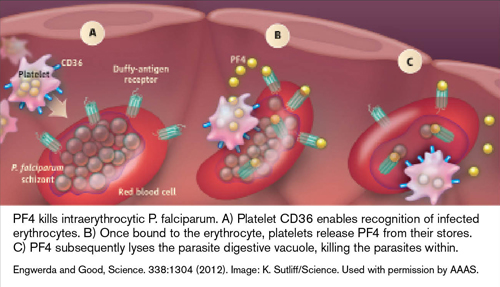Platelets are increasingly recognized for their role in innate immunity. Their capacity to detect erythrocytes infected with malarial parasites and kill the invading organism is a remarkable example of this function. Studies evaluating the physiologic significance of platelet-mediated killing in controlling malaria have demonstrated that both thrombocytopenia and inhibition of platelet activity increase mortality in mouse models of the disease.1 These observations raise the question of how platelets recognize infected red cells and destroy the invading parasites.
PF4 Kills Intraerythrocytic P. Falciparum. A) Platelet CD36 enables recognition of infected erythrocytes. B) Once bound to the erythrocyte, platelets release PF4 from their stores. C) PF4 subsequently lyses the parasite digestive vacuole, killing the parasites within.Engwerda and Good, Science. 338:1304 (2012). Image: K. Sutliff/Science. Used with permission by AAAS.
PF4 Kills Intraerythrocytic P. Falciparum. A) Platelet CD36 enables recognition of infected erythrocytes. B) Once bound to the erythrocyte, platelets release PF4 from their stores. C) PF4 subsequently lyses the parasite digestive vacuole, killing the parasites within.Engwerda and Good, Science. 338:1304 (2012). Image: K. Sutliff/Science. Used with permission by AAAS.
Studies from the laboratory of Dr. Simon Foote at the Menzies Research Institute in Hobart, Tasmania, now demonstrate that platelet factor 4 (PF4, CXCL4) mediates malarial parasite killing via interactions with Duffy antigen on erythrocytes. In a follow-up study of their work showing that platelets kill P. falciparum,1 Dr. Foote’s group found that activated platelets use CD36 to bind to erythrocytes. Platelets then release PF4, which is highly concentrated in platelet granules. Immunofluorescence of red cells infected with P. falciparum demonstrates colocalization of PF4 with dead intraerythrocytic parasites following exposure to platelets. Subsequent studies found that PF4 binds to the chemokine receptor Duffy antigen. The investigators showed that purified PF4 killed P. falciparum within erythrocytes expressing Duffy antigen, but not in red cells that lacked this surface antigen. These results support a model in which platelets bind to infected red cells and release PF4, which then kills the intracellular parasite (Figure).
Working independently at the University of Pennsylvania, Melissa S. Love and colleagues screened a panel of human defense peptides to discover circulating proteins that possess activity against P. falciparum.The screen identified PF4 as the most potent inhibitor of parasite survival. PF4 is made up of an N-terminal domain, a central domain, and an amphipathic C-terminal domain. The authors localized the antimalarial activity of PF4 to a 12-amino-acid amphipathic helical domain at the C-terminus of the peptide. Based on this analysis, they screened a library of small molecules capable of adopting amphipathic secondary structures to identify compounds capable of killing P. falciparum. Two compounds, PMX1207 and PMX207, demonstrated potency at nanomolar concentrations against both chloroquine-sensitive and chloroquine-resistant strains of the organism. The two compounds were subsequently tested in mouse models of malaria. Both PMX1207 and PMX207 decreased parasitemia as measured by the number of erythrocytes containing lysed parasitic digestive vacuoles. In a murine malaria model, PMX207 totally reversed P. berghei-induced death.
Nearly half the world’s population is at risk for malaria, and 216 million cases were reported in 2010. The parasite is so prevalent and so lethal that it has created a selective pressure that has altered the genetic composition of the human population in the at-risk areas. Among the genes that have been selected against is the Duffy antigen, which serves as a receptor for the parasite. The work by McMorran et al., however, reveals the flip side of this story. The Duffy antigen on erythrocytes serves as the binding site for platelet-derived PF4 that mediates killing of the parasite. Whether Duffy-negative individuals have an alternative mechanism for controlling parasite growth is not known. However, this new understanding of the role of PF4 in killing parasites within erythrocytes has informed the development of drugs based on PF4 structure, directing the design of a new class of antimalarials capable of killing chloroquine-resistant P. falciparum. If converted to orally available drugs, this novel approach to treat malaria could have a significant impact on an enormous global health problem.

